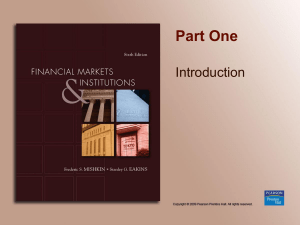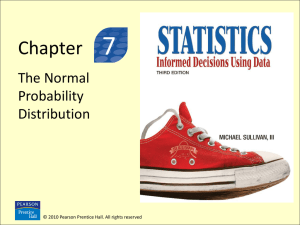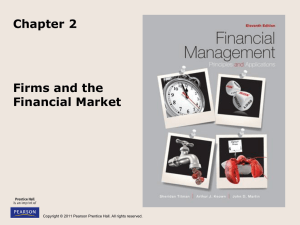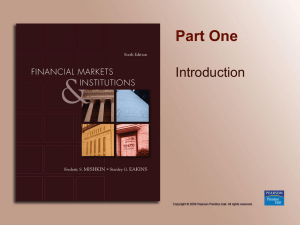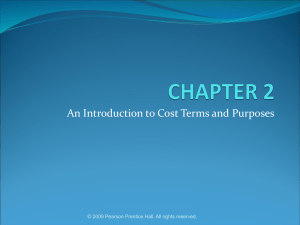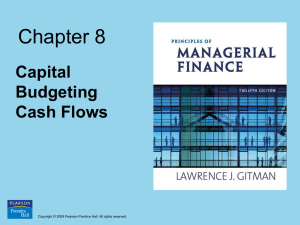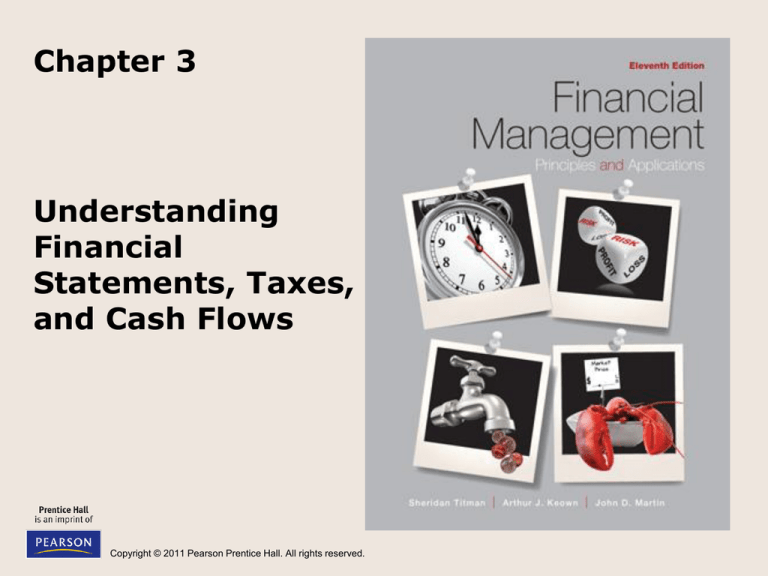
Chapter 3
Understanding
Financial
Statements, Taxes,
and Cash Flows
Copyright © 2011 Pearson Prentice Hall. All rights reserved.
Basic Financial Statements
• Following four types of financial
statements are mandated by the
accounting and financial regulatory
authorities:
1.
2.
3.
4.
Income statement
Balance sheet
Cash flow statement
Statement of shareholder’s equity
Copyright © 2011 Pearson Prentice Hall. All rights reserved.
3-2
Basic Financial Statements (cont.)
Income Statement:
– An income statement provides the following
information for a specific period of time (for
example, a year or 6 months or 3 months):
• Revenue,
• Expenses, and
• Profit.
Copyright © 2011 Pearson Prentice Hall. All rights reserved.
3-3
Basic Financial Statements (cont.)
Balance sheet:
– Balance sheet provides a snap shot of the
following on a specific date (for example, as of
December 31, 2010)
• Assets (value of what the firm owns),
• Liabilities (value of firm’s debts), and
• Shareholder’s equity (the money invested by the
company owners, or Assets - Liabilities).
Copyright © 2011 Pearson Prentice Hall. All rights reserved.
3-4
Basic Financial Statements (cont.)
Cash flow statement:
– Reports cash received and cash spent by the
firm over a period of time (for example, over
the last 6 months).
Copyright © 2011 Pearson Prentice Hall. All rights reserved.
3-5
Basic Financial Statements (cont.)
Statement of shareholder’s equity:
– It provides a detailed account of the firm’s
activities in the following accounts over a
period of time (for example, last six months):
•
•
•
•
Common stock account,
Preferred stock account,
Retained earnings account, and
Changes to owner’s equity.
Copyright © 2011 Pearson Prentice Hall. All rights reserved.
3-6
Why Study Financial Statements?
• Analyzing a firm’s financial statement can help
managers carry out three important tasks:
1. Assess current performance through financial
statement analysis,
2. Monitor and control operations, and
3. Forecast future performance.
Copyright © 2011 Pearson Prentice Hall. All rights reserved.
3-7
What are the Accounting Principles Used
to Prepare Financial Statements?
• The following three fundamental principles are
adhered to by accountants when preparing
financial statements:
1. The revenue recognition principle,
2. The matching principle, and
3. The historical cost principle.
• An understanding of these basic principles allows
us to be a more informed user of financial
statements.
Copyright © 2011 Pearson Prentice Hall. All rights reserved.
3-8
What are the Accounting Principles Used
to Prepare Financial Statements? (cont.)
The revenue recognition principle:
–
It states that the revenue should be included
in the firm’s income statement for the period
in which:
• Its goods and services were exchanged for
cash or accounts receivable; or
• The firm has completed what it must do to
be entitled to the cash.
Copyright © 2011 Pearson Prentice Hall. All rights reserved.
3-9
What are the Accounting Principles Used
to Prepare Financial Statements? (cont.)
The matching principle:
– Expenses are matched with the revenues they
helped produce.
• For example, employees’ salaries are recognized
when the product produced as a result of that work is
sold, and not when the wages were paid.
Copyright © 2011 Pearson Prentice Hall. All rights reserved.
3-10
What are the Accounting Principles Used
to Prepare Financial Statements? (cont.)
The historical cost principle:
– Most assets and liabilities are reported in the
firm’s financial statements at historical cost i.e.
the price the firm paid to acquire them.
– The historical cost generally does not equal the
current market value of the assets or liabilities.
Copyright © 2011 Pearson Prentice Hall. All rights reserved.
3-11
An Income Statement
• An income statement is also called a profit
and loss statement.
• An income statement measures the
amount of profits (net income) generated
by a firm over a given time period (usually
a year or a quarter).
Copyright © 2011 Pearson Prentice Hall. All rights reserved.
3-12
An Income Statement (cont.)
• Income statement can be expressed as
follows:
Revenues – Expenses = Profits (net income)
Copyright © 2011 Pearson Prentice Hall. All rights reserved.
3-13
An Income Statement (cont.)
• An income statement will contain the
following basic elements:
1. Revenues
2. Expenses
• Cost of goods sold, Interest expenses, SGA (selling,
general and administrative) expense, depreciation
expense, Income tax expense
3. Profits
• Gross profit, net operating income (also known as
EBIT), earnings before taxes (EBT), and net income
Copyright © 2011 Pearson Prentice Hall. All rights reserved.
3-14
An Income Statement (cont.)
Sales
– Minus Cost of Goods Sold
= Gross Profit
Minus Operating Expenses
– Selling expenses
– General and Administrative expenses
– Depreciation and Amortization Expense
= Operating income (EBIT)
Minus Interest Expense
= Earnings before taxes (EBT)
Minus Income taxes
= Net income (EAT)
– EBIT = Earnings before interest and taxes; EBT = Earnings before
taxes; EAT = Earnings after taxes
Copyright © 2011 Pearson Prentice Hall. All rights reserved.
3-15
Sample Income Statement
Copyright © 2011 Pearson Prentice Hall. All rights reserved.
3-16
Evaluating a Firm’s EPS and
Dividends
• We can use the income statement to
determine the earnings per share (EPS)
and dividends.
• EPS = Net income÷ Number of shares
outstanding
Copyright © 2011 Pearson Prentice Hall. All rights reserved.
3-17
Evaluating a Firm’s EPS and
Dividends (cont.)
• Example 1: A firm reports a net income
$90 million and has 35 million shares
outstanding, what will be the earnings per
share (EPS)?
• EPS = Net income ÷ Number of shares
= $90 million ÷ $35 million
= $2.57
Copyright © 2011 Pearson Prentice Hall. All rights reserved.
3-18
Evaluating a Firm’s EPS and
Dividends (cont.)
• We can determine the dividends paid by
the firm to each shareholder by dividing
the total amount of dividend (reported on
the income statement) by the total
number of shares outstanding.
• Dividends per share = Dividends ÷
Number of shares
Copyright © 2011 Pearson Prentice Hall. All rights reserved.
3-19
Evaluating a Firm’s EPS and
Dividends (cont.)
• Example 2: A firm reports dividend
payment of $20 million on its income
statement and has 35 million shares
outstanding. What will be the dividends
per share?
• Dividends per share = Dividends ÷
Number of shares
= $20 million ÷ $35 million
= $0.57
Copyright © 2011 Pearson Prentice Hall. All rights reserved.
3-20
Connecting the Income Statement
and the Balance Sheet
• What can the firm do with the net
income?:
1. Pay dividends to shareholders, and/or
2. Reinvest in the firm
Copyright © 2011 Pearson Prentice Hall. All rights reserved.
3-21
Connecting the Income Statement
and the Balance Sheet (cont.)
• Example 3: Review examples 1 & 2. How
much was retained or reinvested by the
firm?
• Amount retained = Net Income –
Dividends
= $90m - $20m = $70m
• The firm’s balance on retained earnings
will increase by $70 million on the balance
sheet.
Copyright © 2011 Pearson Prentice Hall. All rights reserved.
3-22
GAAP and Earnings Management
• While firms must adhere to a set of
accounting principles, GAAP (Generally
Accepted Accounting Principles), there is
considerable room for managers to
influence the firm’s reported earnings.
• Managers have an incentive to tamper
with reported earnings - their pay depends
upon it!
Copyright © 2011 Pearson Prentice Hall. All rights reserved.
3-23
Corporate Taxes
• A firm’s income tax liability is calculated
using its taxable income and the tax rates
on corporate income.
• See the table on next slide for corporate
tax rates.
Copyright © 2011 Pearson Prentice Hall. All rights reserved.
3-24
Corporate tax rates
Copyright © 2011 Pearson Prentice Hall. All rights reserved.
3-25
Corporate tax rates
• The table reveals the following:
– Tax rates range from 15% to 39%
– Tax rates are progressive i.e. larger
corporations with higher profits will tend to pay
more taxes compared to smaller firms with
lower profits.
– Note: In addition to federal taxes, a firm may
face State and City taxes.
Copyright © 2011 Pearson Prentice Hall. All rights reserved.
3-26
Marginal and Average Tax Rates
• While analyzing the tax consequences of a
new business venture, the appropriate tax
rate is the marginal tax rate.
• Marginal tax rate is the tax rate that the
company will pay on its next dollar of
taxable income.
• Average tax rate is total taxes paid
divided by the taxable income.
Copyright © 2011 Pearson Prentice Hall. All rights reserved.
3-27
Marginal and Average Tax Rates
• What is the average and marginal tax
liability for a firm reporting $100,000 as
taxable income.
Taxable
Income
Marginal
tax rate
Incremental
Tax Liability
Cumulative
Tax
Liability
$50,000
15%
7,500
7,500
$75,000
25%
6,250
13,750
$100,000
34%
8,500
22,250
Copyright © 2011 Pearson Prentice Hall. All rights reserved.
Average
Tax Rate
22.25%
3-28
Marginal and Average Tax Rates
• Average tax rate
– = Total tax liability ÷ Total taxable income
– = $22,250 ÷ $100,000
– = 22.25%
• Marginal tax rate
– = 39% as the firm will have to pay 39% on its
next dollar of taxable income i.e. if its taxable
income increases from $100,000 to $100,001.
Copyright © 2011 Pearson Prentice Hall. All rights reserved.
3-29
Dividend Exclusion for Corporate
Shareholders
• Dividends received by corporate stockholders are
partially exempt from taxation. The rationale is to
avoid double taxation at the corporate level. The
percentage of exempt taxes is based on the
degree of ownership of the firm.
• Note dividends for non-corporate investors, like
you and me, are not exempt from taxation – they
are actually double-taxed.
Copyright © 2011 Pearson Prentice Hall. All rights reserved.
3-30
Dividend Exclusion for Corporate
Shareholders
• What will be ABC’s taxable income if firm
ABC receives $200,000 in dividends from
firm XYZ?
– The taxable income will depend on the degree
of ownership of XYZ by ABC.
– See next slide.
Copyright © 2011 Pearson Prentice Hall. All rights reserved.
3-31
Dividend Exclusion for Corporate
Shareholders (cont.)
Ownership
Interest
Dividend
Exclusion
Dividend
Income
Taxable
Dividend
Income
Less than
20%
20% to
79%
70%
$200,000
$60,000
75%
$200,000
$50,000
80% or
more
100%
$200,000
$0
Copyright © 2011 Pearson Prentice Hall. All rights reserved.
3-32
The Balance Sheet
• The balance sheet provides a snapshot of
the firm’s financial position on a specific
date.
• The balance sheet is defined by the
following equation:
Total Assets = Total Liabilities + Total Shareholder’s Equity
Copyright © 2011 Pearson Prentice Hall. All rights reserved.
3-33
The Balance Sheet (cont.)
• Total assets represents the resources
owned by the firm.
• Total liabilities represent the total
amount of money the firm owes its
creditors
• Total shareholders’ equity refers to the
difference in the value of the firm’s total
assets and the firm’s total liabilities.
Copyright © 2011 Pearson Prentice Hall. All rights reserved.
3-34
The Balance Sheet (cont.)
• The balance sheet includes the following
main components:
1. Assets – Found on the left-hand side
of the balance sheet. It includes current
assets and fixed assets.
2. Sources of financing – Found on the
right-hand side of the balance sheet. It
includes current liabilities, long-term
liabilities, and owner’s equity.
Copyright © 2011 Pearson Prentice Hall. All rights reserved.
3-35
The Balance Sheet (cont.)
• In general, GAAP requires that the firm
report assets on its balance sheet at their
historical costs.
• Cash and assets held for sale (such as
marketable securities) are an exception to
the rule. These assets are reported using
the lower of their cost or current market
value.
Copyright © 2011 Pearson Prentice Hall. All rights reserved.
3-36
The Balance Sheet (cont.)
• Assets whose value is expected to decline
over time (such as equipment) are
reported as “net assets” which are equal to
the historical cost minus accumulated
depreciation.
• Note, the net asset value reported on
balance sheet could be significantly
different from the market value of the
asset.
Copyright © 2011 Pearson Prentice Hall. All rights reserved.
3-37
The Balance Sheet (cont.)
• Current assets consists of firm’s cash
plus other assets the firm expects to
convert to cash within 12 months or less,
such as receivables and inventory.
• Fixed (Long-term) assets are assets
that the firm does not expect to sell within
one year. For example, plant and
equipment, land.
Copyright © 2011 Pearson Prentice Hall. All rights reserved.
3-38
The Balance Sheet (cont.)
• Current liabilities: amount owed to
creditors due within 12 months or less
– Examples: Accounts Payable, Notes Payable.
• Long-term liabilities: debt with
maturities longer than a year
– Examples: Bank loans, Bonds.
Copyright © 2011 Pearson Prentice Hall. All rights reserved.
3-39
The Balance Sheet (cont.)
• The stockholder’s equity is broken down
into two components:
(1)The amount the company received from selling
stock to investors (Common/Preferred Stock).
(2) Retained Earnings
Copyright © 2011 Pearson Prentice Hall. All rights reserved.
3-40
The Balance Sheet (cont.)
• We can also express stockholders’ equity
as follows:
Shareholders' equity = Total Assets – Total
Liabilities
Copyright © 2011 Pearson Prentice Hall. All rights reserved.
3-41
Firm Liquidity and Net Working Capital
• Liquidity refers to the speed with which
an asset can be converted to cash without
loss of value.
• For example, a firm’s bank account is perfectly
liquid.
• Other types of assets (A/R, Inventory, PP&E), are
less liquid as they are more difficult to sell and
convert to cash.
Copyright © 2011 Pearson Prentice Hall. All rights reserved.
3-42
Firm Liquidity and Net Working
Capital
• We can thus measure a firm’s liquidity by
computing:
net working capital = current assets – current liabilities
Copyright © 2011 Pearson Prentice Hall. All rights reserved.
3-43
Firm Liquidity and Net Working
Capital (cont.)
• If a firm’s net working capital is
significantly positive, it is in a good
position to pay its debts.
• Lenders consider net working capital as an
important indicator of firm’s ability to
repay its loans.
Copyright © 2011 Pearson Prentice Hall. All rights reserved.
3-44
The
Balance
Sheet
Copyright © 2011 Pearson Prentice Hall. All rights reserved.
3-45
Debt and Equity Financing
• The right-hand side of the balance sheet
reveals the sources of money used to
finance the purchase of the firm’s assets
listed on the left-hand side of the balance
sheet.
• It shows how much was borrowed (debt
financing) and how much was provided by
firm’s owners (equity financing, through
the sale of equity or retention of prior
year’s earnings).
Copyright © 2011 Pearson Prentice Hall. All rights reserved.
3-46
Debt versus Equity
• Payment: Payment for debt holders is
generally fixed (in the form of interest);
Payment for equity holders (dividends) is
neither fixed nor guaranteed.
• Seniority: Debt holders are paid before
equity holders in the event of bankruptcy.
• Maturity: Debt matures after a fixed period
while equity securities do not mature.
Copyright © 2011 Pearson Prentice Hall. All rights reserved.
3-47
The Cash Flow Statement
• The Cash Flow Statement is used by
firms to explain changes in their cash
balances over a period of time by
identifying all of the sources and uses of
cash.
Copyright © 2011 Pearson Prentice Hall. All rights reserved.
3-48
Sources and Uses of Cash
• Source of cash is any activity that brings
cash into the firm. For example, making
sales.
• Use of cash is any activity that causes
cash to leave the firm. For example,
payment of taxes.
Copyright © 2011 Pearson Prentice Hall. All rights reserved.
3-49
Cash Flow Statement
• The format for a traditional cash flow statement
is as follows:
Beginning Cash Balance
+ or -: Cash Flow from Operating Activities
+ or -: Cash Flow from Investing Activities
+ or -: Cash Flow from Financing Activities
Equals: Ending Cash Balance
Copyright © 2011 Pearson Prentice Hall. All rights reserved.
3-50
Cash Flow Statement (cont.)
• Operating activities represent the company’s core
business including sales and expenses. Basically
any activity that affects net income for the period.
• Investing activities include the cash flows that
arise out of the purchase and sale of long-term
assets such as plant and equipment.
• Financing activities represent changes in the
firm’s use of debt and equity such as issue of new
shares, payment of dividends.
Copyright © 2011 Pearson Prentice Hall. All rights reserved.
3-51
Balance Sheet for
H.J. Boswell, Inc.
Copyright © 2011 Pearson Prentice Hall. All rights reserved.
3-52
H.J. Boswell,
Inc.
Statement of
Cash Flows
Copyright © 2011 Pearson Prentice Hall. All rights reserved.
3-53
Cash Flow Analysis (cont.)
• An analysis of H.J. Boswell’s operations reveals
the following for 2010:
– The firm used more cash than it generated,
resulting in a deficit of $4.5 million
– The primary source of cash flow was operating
activities followed by long-term debt ($51.75
million)
– The largest use of cash was for acquiring
inventory at $148.5 million.
Copyright © 2011 Pearson Prentice Hall. All rights reserved.
3-54


